Physical Properties of Concrete Containing Graphene Oxide Nanosheets
Abstract
:1. Introduction
2. Materials and Methods
2.1. Materials
2.2. Concrete Mix and Specimen Preparation
2.3. Physical Property Tests and Slump Test
3. Results and Discussion
3.1. Workability
3.2. Compressive Strength
3.3. Flexural Strength and Relationship between Compressive and Flexural Strength
3.4. Split Tensile Strength
4. Conclusions
- (1)
- The slump of concrete containing GO nanosheets decreases with the addition of GO nanosheets from 0.02% to 0.80% by weight of cement under a water to cement ratio of 0.5. However, the workability of concrete is affected by both the additive and the GNPs. Therefore, further study is needed to better understand the influence of GO nanosheets on the workability of concrete.
- (2)
- The compressive strength of the concrete is enhanced by an increase at the level of GO nanosheets from 0.02% to 0.08% for the water–cement ratio of 0.5. It may be associated with many factors, such as the promotion of the hydration process, the “bridging effect” of GO nanosheets for microcracks, etc. This will be subjected to further examination by SEM.
- (3)
- The addition of GO nanosheets improves the flexural strength of concrete in a range from 2.77% to 15.60% at 28 days when the content of GO nanosheets increases from 0.02% to 0.08%. However, the rate of increase in the flexural strength is generally less than that of the compressive strength.
- (4)
- The split tensile strength of the specimens with a water–cement ratio of 0.5 generally increases with increasing GO nanosheets content. The results also indicate that 0.03% is the optimum value of GO nanosheet dosage for improving the split tensile strength of the concrete specimens with a water–cement ratio of 0.5.
Author Contributions
Funding
Acknowledgments
Conflicts of Interest
References
- Mehta, P.K.; Monteiro, P.J. Concrete: Microstructure, Properties, and Materials, 3rd ed.; McGraw-Hill: New York, NY, USA, 2006. [Google Scholar]
- Václavík, V.; Dvorský, T.; Šimíček, V.; Ondová, M.; Valíček, J.; Kušnerová, M.; Gola, L. Steel slag as a substitute for natural aggregate in the production of concrete. Solid State Phenom. 2016, 244, 77–87. [Google Scholar] [CrossRef]
- Shamsaei, E.; de Souza, F.B.; Yao, X.; Benhelal, E.; Akbari, A.; Duan, W.H. Graphene-based nanosheets for stronger and more durable concrete: A review. Constr. Build. Mater. 2018, 183, 642–660. [Google Scholar] [CrossRef]
- U.S. Geological Survey. Mineral Commodity Summaries, Cement Statistics and Information. 2019. Available online: https://minerals.usgs.gov/minerals/pubs/mcs/ (accessed on 15 February 2019).
- Zhang, C. China’s Cement Industry Could Crack as Tougher Environmental Laws Bite. 2015. Available online: https://www.chinadialogue.net/article/show/single/en/ (accessed on 15 August 2018).
- Sanchez, F.; Sobolev, K. Nanotechnology in concrete—A review. Constr. Build. Mater. 2010, 24, 2060–2071. [Google Scholar] [CrossRef]
- Pan, Z.; He, L.; Qiu, L.; Korayem, A.H.; Li, G.; Zhu, J.W.; Collins, F.; Li, D.; Duan, W.H.; Wang, M.C. Mechanical properties and microstructure of a graphene oxide-cement composite. Cement Concr. Compos. 2015, 58, 140–147. [Google Scholar] [CrossRef]
- Lv, S.; Ma, Y.; Qiu, C.; Sun, T.; Liu, J.; Zhou, Q. Effect of graphene oxide nanosheets of microstructure and mechanical properties of cement composites. Constr. Build. Mater. 2013, 49, 121–127. [Google Scholar] [CrossRef]
- Liu, Q.; Xu, Q.; Yu, Q.; Gao, R.; Tong, T. Experimental investigation on mechanical and piezoresistive properties of cementitious materials containing graphene and graphene oxide nanoplatelets. Constr. Build. Mater. 2016, 127, 565–576. [Google Scholar] [CrossRef]
- Mohammed, A.; Sanjayan, J.G.; Duan, W.H.; Nazari, A. Incorporating graphene oxide in cement composites: A study of transport properties. Constr. Build. Mater. 2015, 84, 341–347. [Google Scholar] [CrossRef]
- Lv, S.; Zhang, J.; Zhu, L.; Jia, C. Preparation of Cement Composites with Ordered Microstructures via Doping with Graphene Oxide Nanosheets and an Investigation of Their Strength and Durability. Materials 2016, 9, 924. [Google Scholar] [CrossRef] [PubMed]
- Tong, T.; Fan, Z.; Liu, Q.; Wang, S.; Tan, S.; Yu, Q. Investigation of the effects of graphene and graphene oxide nanoplatelets on the micro- and macro-properties of cementitious materials. Constr. Build. Mater. 2016, 106, 102–114. [Google Scholar] [CrossRef]
- Mohammed, A.; Sanjayan, J.G.; Duan, W.H.; Nazari, A. Graphene Oxide Impact on Hardened Cement Expressed in Enhanced Freeze–Thaw Resistance. J. Mater. Civ. Eng. 2016, 28, 04016072. [Google Scholar] [CrossRef]
- Wang, Q.; Wang, J.; Lv, C.-x.; Cui, X.-y.; Li, S.-y.; Wang, X. Rheological behaviour of fresh cement pastes with a graphene oxide additive. New Carbon Mater. 2016, 31, 574–584. [Google Scholar] [CrossRef]
- Wang, Q.; Cui, X.; Wang, J.; Li, S.; Lv, C.; Dong, Y. Effect of fly ash on rheological properties of graphene oxide cement paste. Constr. Build. Mater. 2017, 138, 35–44. [Google Scholar] [CrossRef]
- Lu, L.; Ouyang, D. Properties of cement mortar and ultra-high strength concrete incorporating graphene oxide nanosheets. Nanomaterials 2017, 7, 187. [Google Scholar] [CrossRef] [PubMed]
- Meng, W.; Khayat, K.H. Mechanical properties of ultra-high-performance concrete enhanced with graphite nanoplatelets and carbon nanofibers. Compos Part B 2016, 107, 113–122. [Google Scholar] [CrossRef]
- Dimov, D.; Amit, I.; Gorrie, O.; Barnes, M.D.; Townsend, N.; Neves, A.S.; Withers, F.; Russo, S.; Craciun, M.F. Ultrahigh Performance Nanoengineered Graphene–Concrete Composites for Multifunctional Applications. Adv. Funct. Mater. 2018, 28, 1705183. [Google Scholar] [CrossRef]
- Xu, Y.; Zeng, J.; Chen, W.; Jin, R.; Li, B.; Pan, Z. A holistic review of cement composites reinforced with graphene oxide. Constr. Build. Mater. 2018, 171, 291–302. [Google Scholar] [CrossRef]
- Yang, H.; Cui, H.; Tang, W.; Li, Z.; Han, N.; Xing, F. A critical review on research progress of graphene/cement based composites. Compos. Part A Appl. Sci. Manuf. 2017, 102, 273–296. [Google Scholar] [CrossRef]
- Marcano, C.D.; Kosynkin, D.V.; Berlin, J.M.; Sinitskii, A.; Sun, Z.Z.; Slesarev, A.; Alemany, L.B.; Lu, W.; Tour, J.M. Improved synthesis of graphene oxide. ACS Nano 2010, 4, 4806–4814. [Google Scholar] [CrossRef] [PubMed]
- Specification for Mix Proportion Design of Ordinary Concrete; JGJ 55-2011; National Standard of China: Beijing, China, 2011. (In Chinese)
- Code for Durability Design of Concrete Structures; GB T22923-2008; National Standard of China: Beijing, China, 2008. (In Chinese)
- Standard for Test Method of Mechanical Properties on Ordinary Concrete; GB/T 50081-2002; National Standard of China: Beijing, China, 2002. (In Chinese)
- Standard for Test Method of Performance on Ordinary Fresh Concrete; GB/T 50080-2002; National Standard of China: Beijing, China, 2002. (In Chinese)
- Collins, F.; Lambert, J.; Duan, W.H. The influences of admixtures on the dispersion, workability, and strength of carbon nanotube-PC paste mixtures. Cement Concr. Compos. 2012, 34, 201–207. [Google Scholar] [CrossRef]
- Han, B.; Sun, S.; Ding, S.; Zhang, L.; Yu, X.; Ou, J. Review of nanocarbon-engineered multifunctional cementitious composites. Compos. Part A Appl. Sci. Manuf. 2015, 70, 69–81. [Google Scholar] [CrossRef]
- Beeby, A.W.; Naranayan, R.S. Designers Handbook to Eurocode 2 Part I: Design of Concrete Structures; Thomas Telford Services Ltd.: London, UK, 1995. [Google Scholar]
- Specifications of Cement Concrete Pavement Design for Highway; JTG 40-2002; National Standard of China: Beijing, China, 2002. (In Chinese)
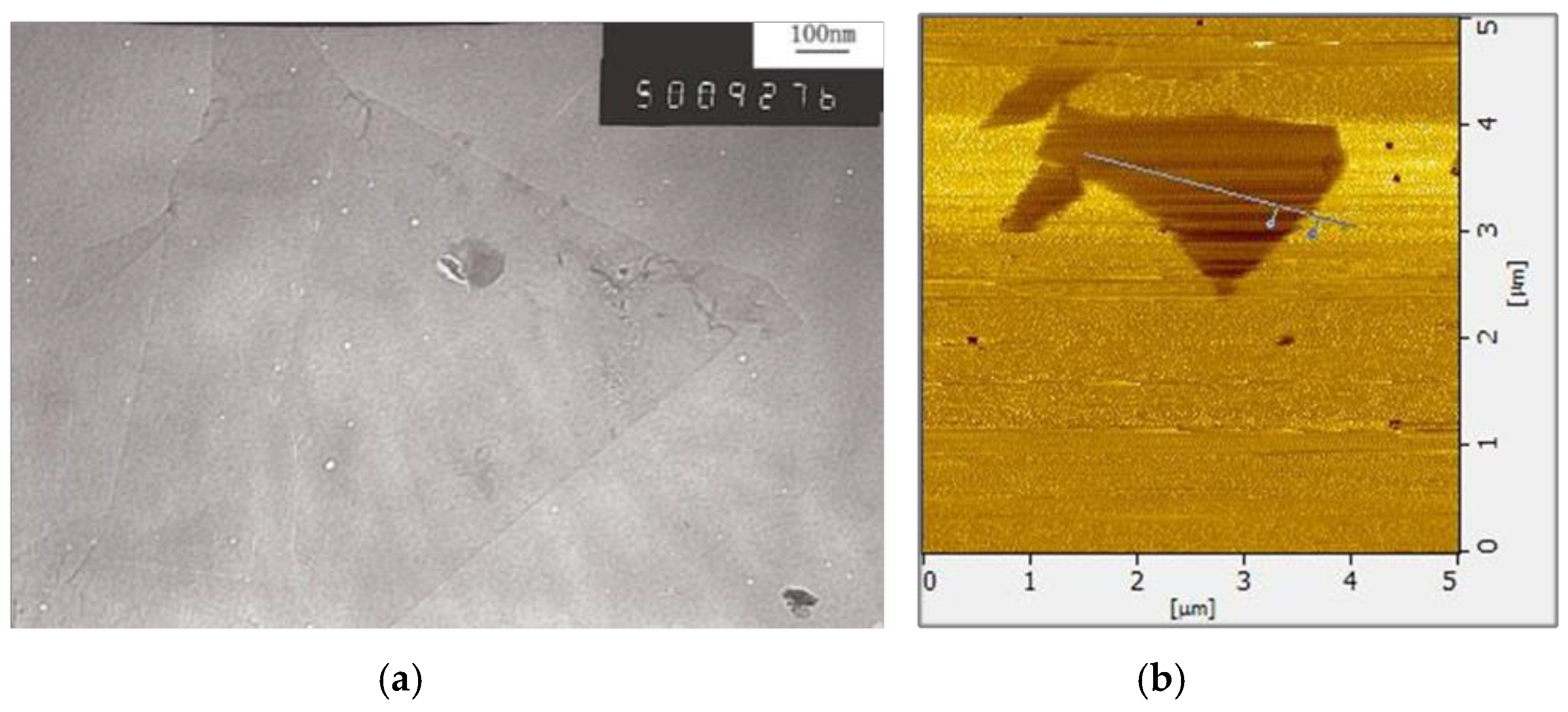
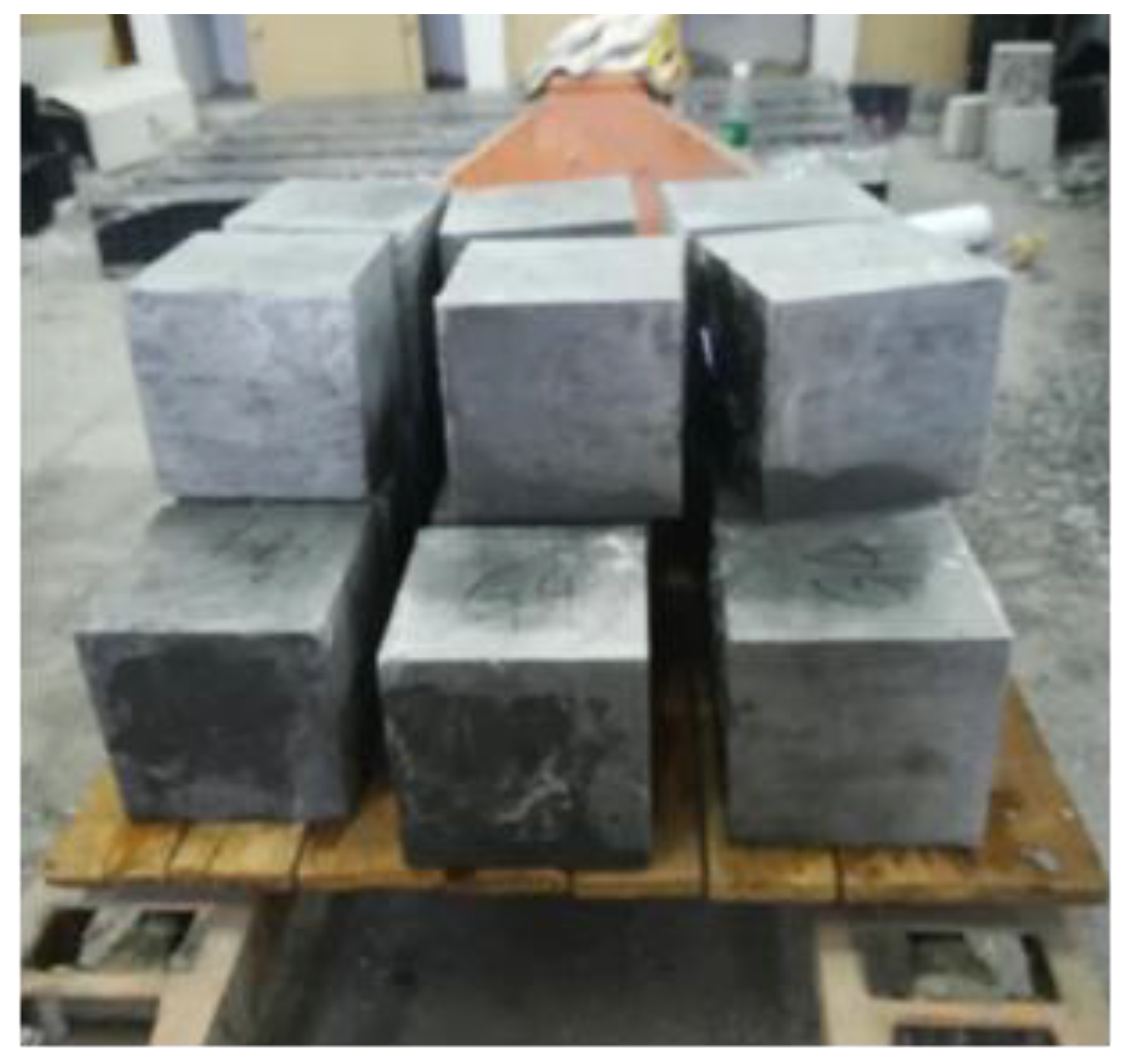
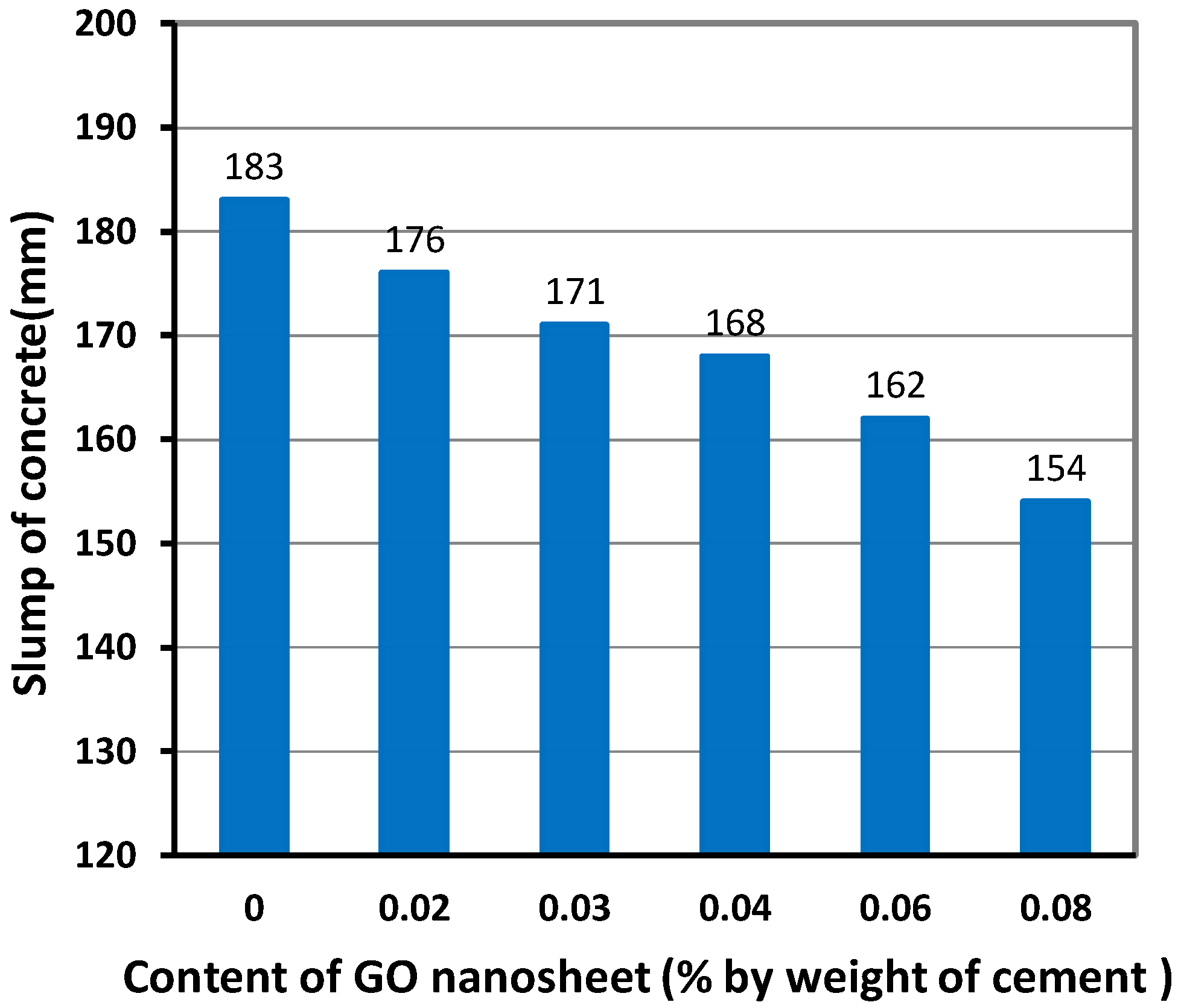
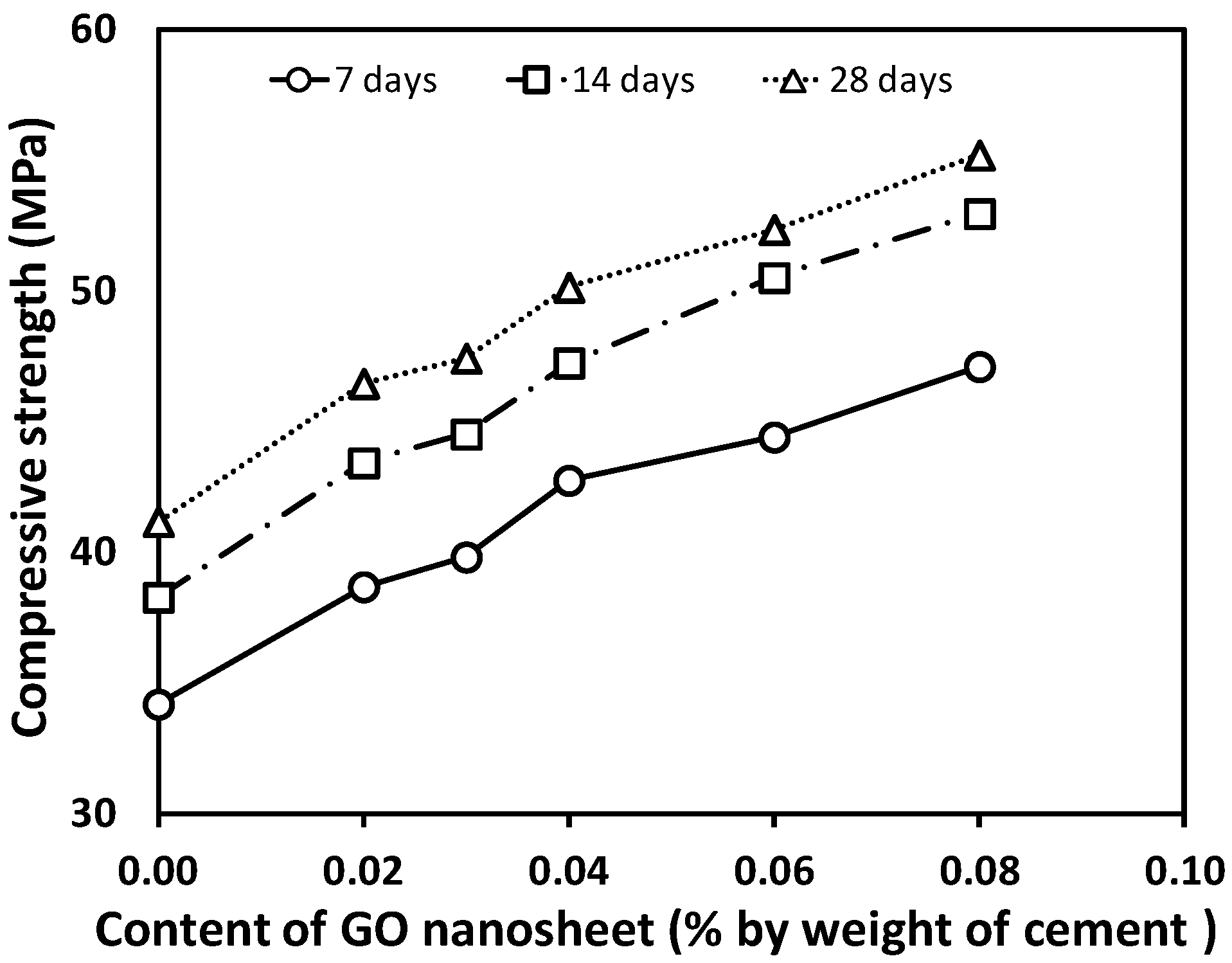
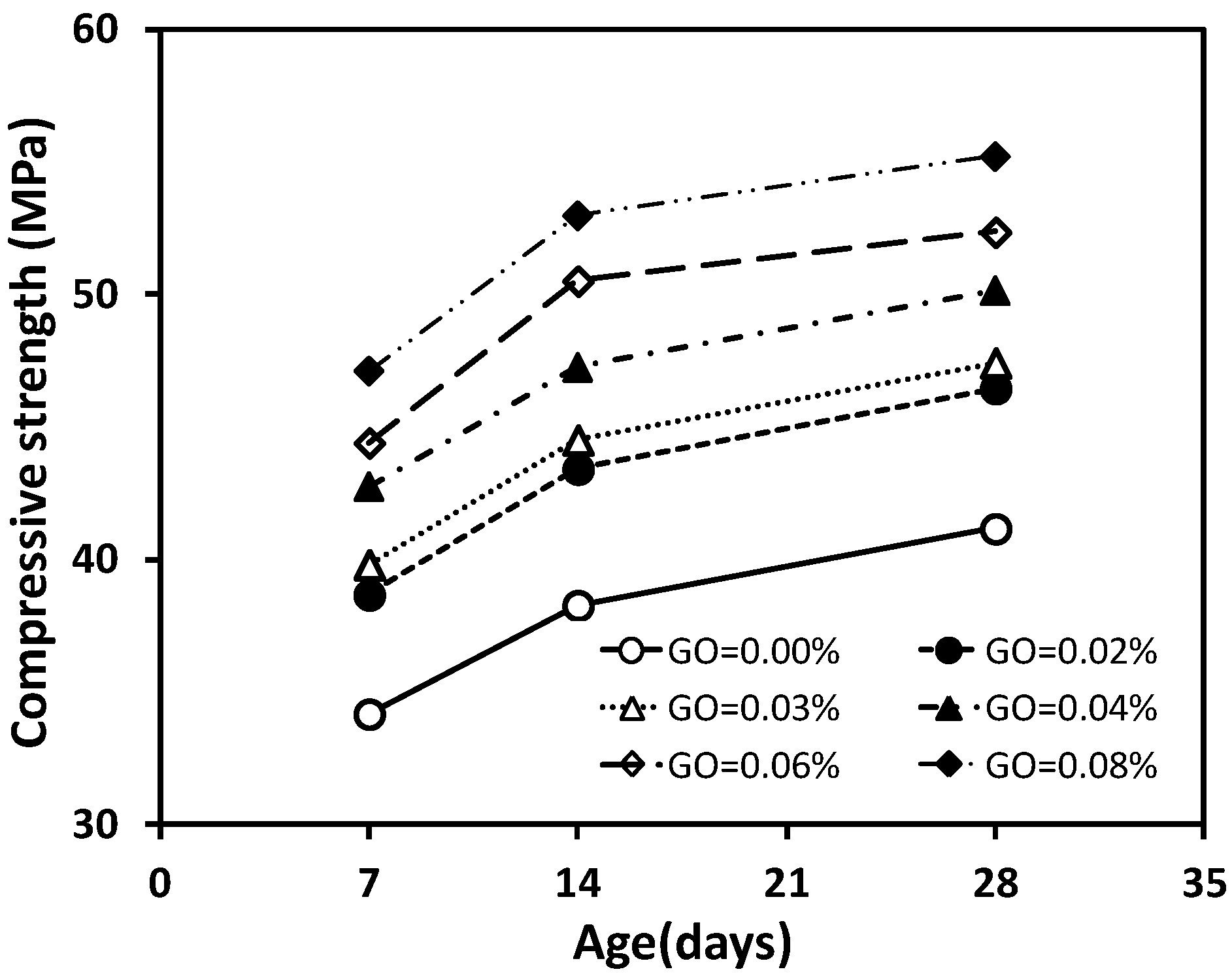
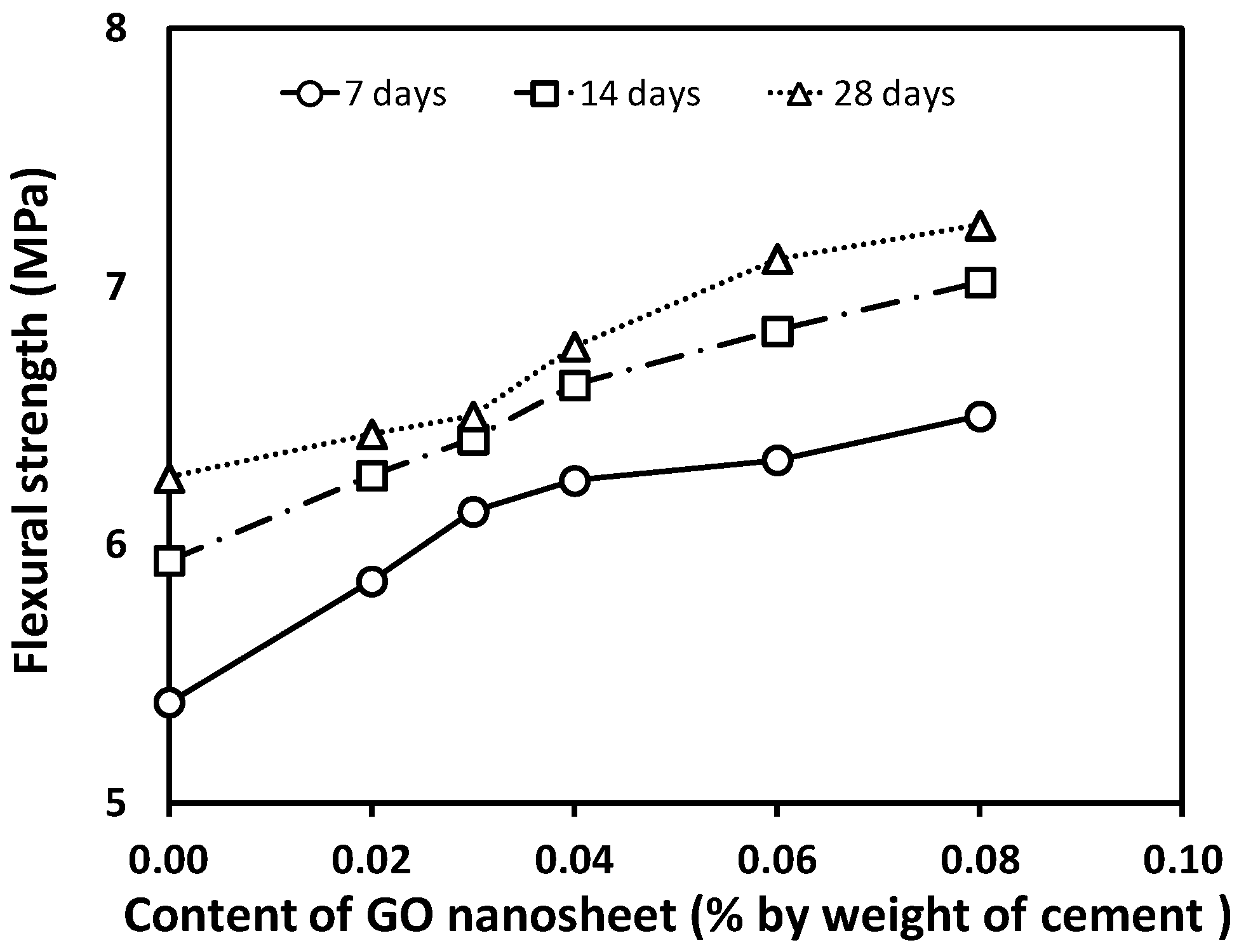
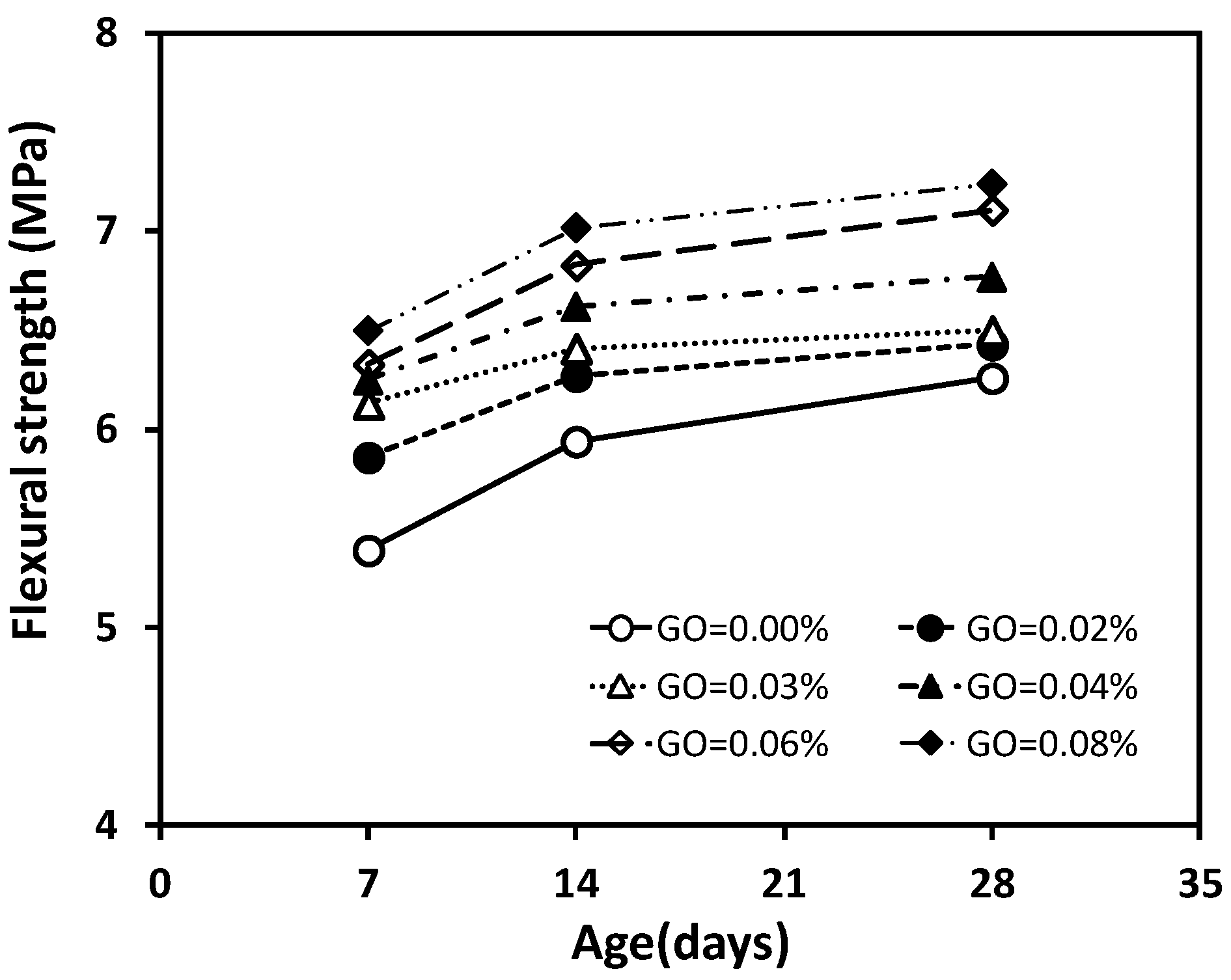
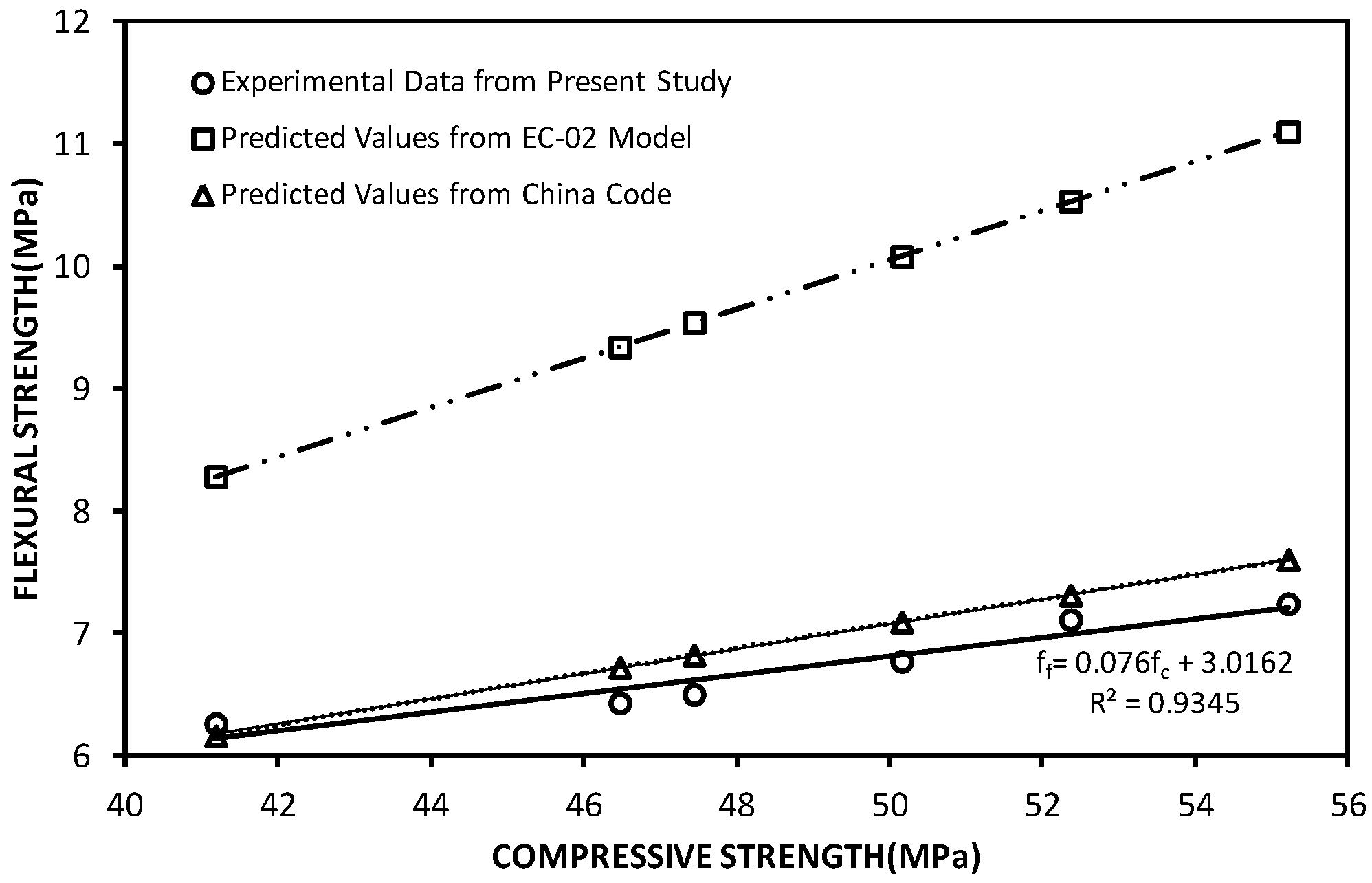
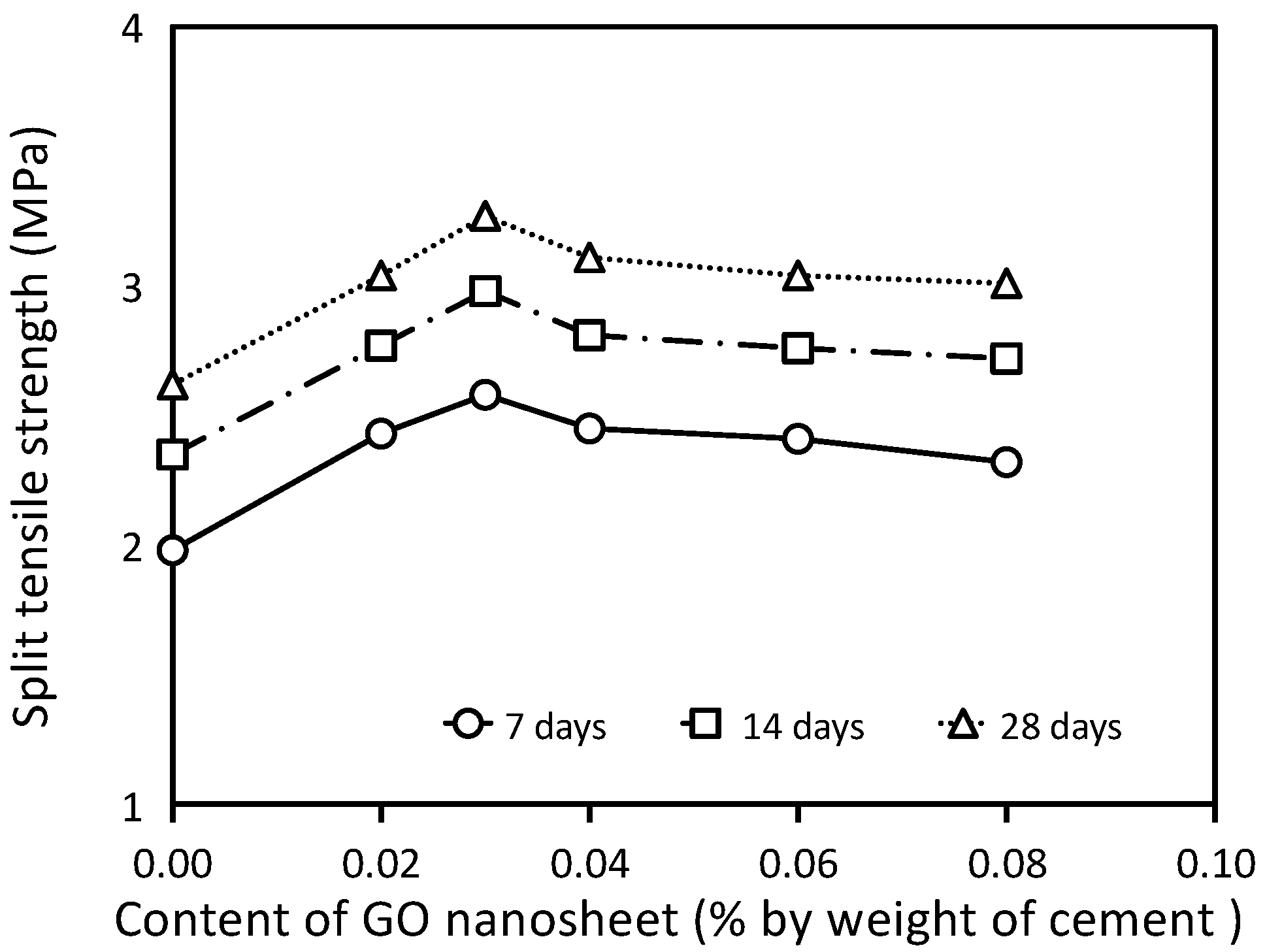
| Component | CaO | SiO2 | Al2O3 | Fe2O3 | MgO | K2O | Na2O | SO3 |
|---|---|---|---|---|---|---|---|---|
| Content (%) | 65.16 | 21.25 | 4.21 | 3.35 | 2.90 | 0.97 | 0.50 | 0.72 |
| Items | Carbon (%) | Oxygen (%) | The Length/Width (μm) | Thickness (nm) |
|---|---|---|---|---|
| Value range | 45–60 | 40–55 | 2–10 | 1–1.5 |
| Mix ID | Total Water (kg/m3) | Cement (kg/m3) | FA (kg/m3) | CA (kg/m3) | PCs (kg/m3) | GO (%) | GO (kg/m3) |
|---|---|---|---|---|---|---|---|
| GCO0 | 168 | 336 | 626 | 1270 | 6.72 | 0.00 | 0.0000 |
| GCO2 | 168 | 336 | 626 | 1270 | 6.72 | 0.02 | 0.0672 |
| GCO3 | 168 | 336 | 626 | 1270 | 6.72 | 0.03 | 0.1008 |
| GCO4 | 168 | 336 | 626 | 1270 | 6.72 | 0.04 | 0.1344 |
| GCO6 | 168 | 336 | 626 | 1270 | 6.72 | 0.06 | 0.2016 |
| GCO8 | 168 | 336 | 626 | 1270 | 6.72 | 0.08 | 0.2688 |
| Test | Size Used (mm) | Standard Size (mm) | Conversion Coefficients |
|---|---|---|---|
| Compressive strength | 100 × 100 × 100 | 150 × 150 × 150 | 0.95 |
| Flexural strength | 100 × 100 × 400 | 150 × 150 × 550 | 0.85 |
| Split tensile strength | 100 × 100 × 100 | 150 × 150 × 150 | 0.85 |
| Mix ID | Compressive Strength on Day 28 (fc) | Flexural Strength (ff) | ||
|---|---|---|---|---|
| Present Study | EC-02 [28] ff = 0.201fc | China Code [29] ff = 0.435 fc 0.713 | ||
| GCO0 | 41.18 | 6.26 | 8.28 | 6.16 |
| GCO2 | 46.47 | 6.43 | 9.34 | 6.72 |
| GCO3 | 47.44 | 6.50 | 9.54 | 6.82 |
| GCO4 | 50.16 | 6.77 | 10.08 | 7.09 |
| GCO6 | 52.37 | 7.11 | 10.53 | 7.31 |
| GCO8 | 55.22 | 7.24 | 11.10 | 7.60 |
| Mix ID | GO (%) | Split Tensile Strength (MPa) | Increase at 28 Days (%) | ||
|---|---|---|---|---|---|
| 7 Days | 14 Days | 28 Days | |||
| GCO0 | 0.00 | 1.98 | 2.35 | 2.62 | 0.00 |
| GCO2 | 0.02 | 2.43 | 2.77 | 3.04 | 16.18 |
| GCO3 | 0.03 | 2.58 | 2.98 | 3.27 | 24.81 |
| GCO4 | 0.04 | 2.45 | 2.81 | 3.11 | 18.75 |
| 4CO6 | 0.06 | 2.41 | 2.76 | 3.04 | 15.95 |
| GCO8 | 0.08 | 2.32 | 2.72 | 3.01 | 14.79 |
© 2019 by the authors. Licensee MDPI, Basel, Switzerland. This article is an open access article distributed under the terms and conditions of the Creative Commons Attribution (CC BY) license (http://creativecommons.org/licenses/by/4.0/).
Share and Cite
Wu, Y.-Y.; Que, L.; Cui, Z.; Lambert, P. Physical Properties of Concrete Containing Graphene Oxide Nanosheets. Materials 2019, 12, 1707. https://doi.org/10.3390/ma12101707
Wu Y-Y, Que L, Cui Z, Lambert P. Physical Properties of Concrete Containing Graphene Oxide Nanosheets. Materials. 2019; 12(10):1707. https://doi.org/10.3390/ma12101707
Chicago/Turabian StyleWu, Yu-You, Longxin Que, Zhaoyang Cui, and Paul Lambert. 2019. "Physical Properties of Concrete Containing Graphene Oxide Nanosheets" Materials 12, no. 10: 1707. https://doi.org/10.3390/ma12101707
APA StyleWu, Y.-Y., Que, L., Cui, Z., & Lambert, P. (2019). Physical Properties of Concrete Containing Graphene Oxide Nanosheets. Materials, 12(10), 1707. https://doi.org/10.3390/ma12101707





